This was published 8 years ago
Why the Kalahari desert is an unforgettable African landscape
By Ute Junker
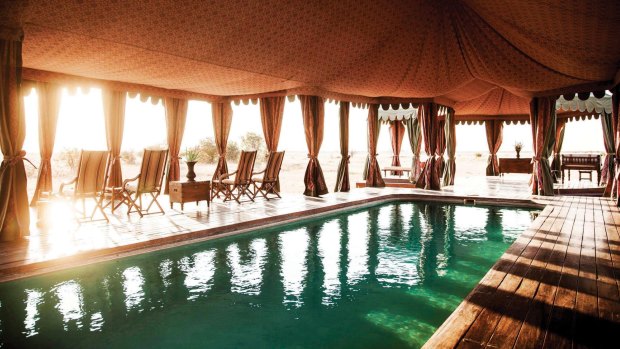
The pool pavilion at Jack's Camp.Credit: David Crookes
Something is wrong, and the meerkat knows it. He has been digging frantically to uncover the scorpion he has scented, but he can't locate his prey. What he doesn't realise is that he has already uncovered the scorpion, and sent it flying over his shoulder amid a spray of sand. The scorpion is behind him, sitting completely still as layers of sand gently settle over him, providing a veneer of camouflage.
The poor meerkat is clearly bewildered by his dinner's disappearance. He repeatedly attacks the hole from different angles, digging ever more frantically. Even though we know he won't understand, we can't resist chorusing, like children at a pantomime, "Look behind you!"
Meerkats, however, are not stupid. Our furry friend eventually looks around, spies the scorpion and, swift as lightning, pounces on it. A few quick crunches later, the scorpion is history.
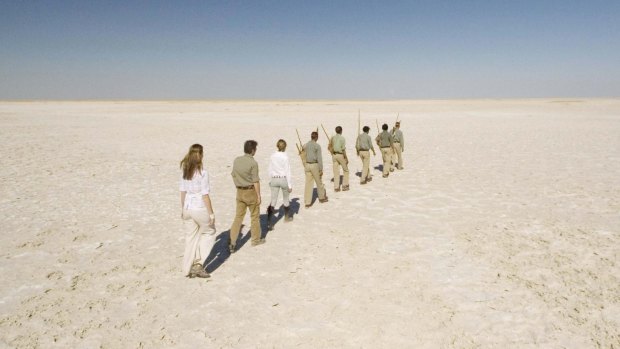
Heading out into the salt pans.Credit: Jack's Camp
Life and death on the African savannah are usually more dramatic: a cheetah streaking after a fleeing antelope, a lion tearing into the soft underbelly of a downed wildebeest. Here in the Kalahari, however, a hostile environment that is both scorchingly hot and punishingly dry, life and death are measured in smaller steps.
Take the meerkat. This cute little critter is actually a finely honed survival machine, each of its habits targeted to one end: making it through until tomorrow. Hence the famous sentinel stance, with at least one meerkat constantly on the lookout for predators.
Under attack, meerkats mount an effective defence, banding together to mob the attacker, whether it is a yellow cobra or a goshawk. Unlike most animals, they will even tend to injured members of their group, feeding those who are incapable of catching their own food.
The meerkats snuggle together like a basketful of kittens.
It takes more than just alertness to survive in this harsh environment, however. Among other biological adaptations, a meerkat's metabolic rate is half what you would expect of an animal of its size. As it produces less body heat, it retains water longer, and can spend more time foraging in the heat of the day.
Even so, meerkats are smart enough to shelter from the sun. Once our scorpion hunter has finished his meal, he retires swiftly to a nearby burrow, where another half dozen meerkats are already curled up. The downside of their slow metabolic rate is that meerkats cool off quickly, so inside their shady burrow, they snuggle together like a basketful of kittens.
ON THE EDGE
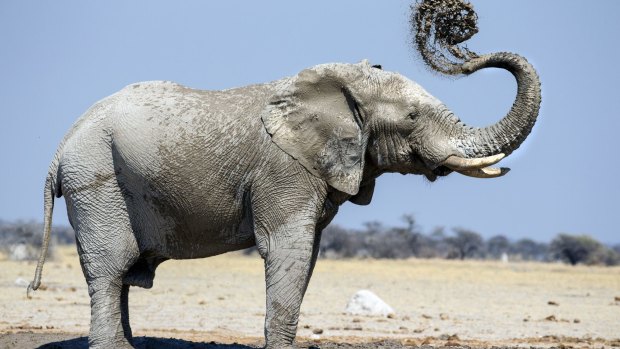
An elephant takes a mud bath in the Kalahari. Credit: Getty
The Kalahari would appear to be a habitat of last resort. Technically, it is not a desert – it falls into the category of semi-arid savannah – yet this dry, featureless terrain that covers 900,000 square kilometres of southern Africa is among the harshest environments you will encounter.
Temperatures can be searing during the day and freezing at night. The nearest permanent water source, the Okavango River, ends in a watery delta a long way to the north.
We have arrived at the end of the dry season, when the landscape is so dry, it appears fossilised. The waterholes have all but dried up, even though the handful of safari camps in the area do their best to pump in extra water. Occasionally, we spy what appears to be a shimmering pool of water in the distance. When we go closer, we invariably find it is yet another dried-up mud pan. Like so many early explorers, we have fallen victim to a mirage.
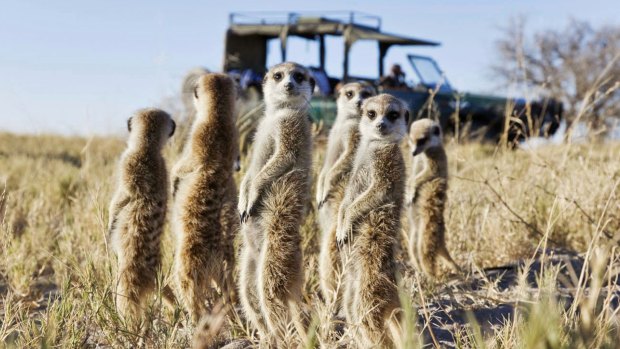
Meerkats have strong survival instincts.Credit: Jack's Camp
Despite the harsh conditions, the Kalahari sustains life. Its complex eco-system supports not just 121 different reptiles, but also an astonishing 32 mammal species. Each of these species has developed a way to survive until the rainy season rolls around and transforms the Kalahari plains.
Our guide, Dabe, explains that when the rains come, the area will teem with life. The bone-dry acacia trees will sprout leaves, while creatures lying dormant beneath the dried-up waterholes – brown shrimp larvae, bullfrogs, even terrapins – will awaken and push their way to the surface.
Unfortunately, the rains are three weeks late. In the blazing morning heat, little moves apart from a handful of hardy birds. There are long-legged secretary birds, pale chanting goshawks, rare Kalahari scrub robins and the distinctive red-crested korhaan, which sounds uncannily like a helicopter as it flies past.
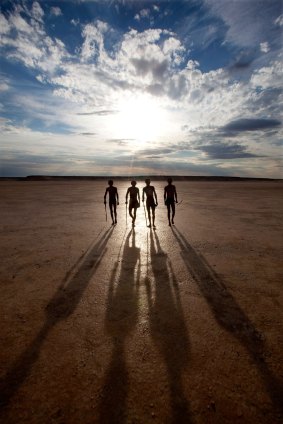
The San belong to one of the oldest populations on earth. Credit: Dan Kitwood/Getty Images
During mating season, it plunges into spectacular tumbles toward the ground, demonstrating that in just about every species, males are happy to do pointless things to impress females.
Dabe belongs to the San tribe. These nomadic people, formerly known as "bushmen", found ways to survive in this hostile landscape, and Dabe shares some of this life-saving knowledge. On one drive, he digs up some underground tubers to show us the water stored in their swollen stems. He then carefully replants them, ensuring they will be there for the next creature that needs them.
Dabe's uncanny ability to mimic the calls of every bird we come across also turns out to be a survival skill. As a child, the birds Dabe caught with slingshots and snares were an important part of his family's diet.
MAKING TRACKS
Surprisingly, the Kalahari is not completely devoid of big game. We see elephants and zebra, wildebeest and impala, even the rare brown hyena. All these animals, however, appear in small groups rather than the vast herds we would expect to see elsewhere in Africa.
Many of them migrate here from the Okavango delta, timing their arrival to coincide with the rainy season. Their routes are inscribed on the landscape. Those scraggly lines of palms, for instance, looking so out of place in this arid environment, mark the paths taken by migrating elephants.
The pachyderms graze on palms in the lush Angolan highlands, excreting the seeds as they travel. Over endless centuries and repeated migrations, the line of palms has grown ever longer, fertilised by the elephants' dung.
This year, the migrating animals have made the mistake of arriving before the rains. Without water, the Kalahari is a killing zone. The newborn calves are particularly vulnerable; we see several of them, already dead or dying.
Older animals are also at risk. They crowd around almost-dry waterholes which, ironically remain deceptively muddy, thanks to the water buried deep in the soil. Occasionally, we see an animal get mired in the boggy mass. Most of the time, they struggle free.
To beat the heat, 60 per cent of the Kalahari's animal population has become nocturnal. Evening drives become part of our routine, and offer plenty of opportunities to spot all kinds of creatures.
Even the zebra are grazing at night, maximising the moisture they get from their feed. I am particularly delighted every time we spot the elongated ears and loping gait of the spring hare, a creature with an oddly kangaroo-like tail.
The paucity of big game doesn't mean there's nothing to see. On every game drive, Dabe shows us something that I have never seen before. Those clumpy knots hanging from bare tree branches? They are the nests of communal spiders. While most spiders are solitary hunters, these arachnids live in colonies of up to 200 insects. They go hunting at night and bring their prey back to share with the rest of their community.
SMALL WONDERS
One question troubles me. The Kalahari is home to hyenas, jackals, and even a pride of lions. Elsewhere in Africa, carnivores rely heavily on antelope, particularly the skittish impala, distributed in large numbers across Africa's wide plains. Here, impala are few and far between. What are the animals at the top of the food chain eating?
It turns out that predators, like the rest of us, have to adapt. Dabe reveals that several species, including the bat-eared fox, the jackal and even a type of hyena, the aardwolf, have developed a taste for an unusual source of protein: the termite.
Termites are one thing that the Kalahari has in abundance. The mounds that soar a metre or more are just the tip of the iceberg: each termite nest can stretch up to 40 metres into the earth, and house up to 2 million termites.
The more I learn about termites, the more fascinated I become. These insects struggle to survive on the food to hand: not only do they lack the enzymes to break down their foodstuff into energy, they also don't get enough nitrogen in their diet. However, they have developed an astonishing solution to the problem.
The dung heaps found inside every termite mound contain a special fungus which lives on termite faeces and alters their chemistry, quadrupling the amount of nitrogen they contain. The termites then reconsume the converted dung; this time, they can break down the food to get the nutrition they require.
ON THE TRAIL OF KILLERS
Other animals have a more straightforward approach to eating. On one drive we come across the remains of a zebra carcass, providing nourishment to a collection of jackals and vultures. Dabe embarks on a forensic examination of the site with the practised eye of a CSI technician. He posits that the animal was downed by a lion, given that there is a trail nearby that is favoured by the big cats.
Sure enough, when we head over, we find lion tracks in the sandy soil. Examining their direction, Dabe creates a plausible scenario. He deduces that the lions were on their way to one of the few waterholes which still contains a small amount of turbid water. They came across their prey, which was probably weak from lack of food, took it down, and ate their fill. We head in the direction that they are likely to have taken after their feast, but despite much searching, we fail to find any sign of them. They have probably found themselves a shady spot to lie while they digest their meal.
We know the feeling. We are staying at Jack's Camp, a luxury safari camp that is considered one of the most indulgent in Africa. From a distance, Jack's Camp may appear to be nothing more than a simple collection of tents. Step inside, however, and you will discover an old-school grandeur reminiscent of those eccentric Victorian travellers who used to head into the wilderness carting grand pianos or clarinets.
The main tent features hardwood floors, Persian carpets, hanging daybeds, velvet armchairs. A short stroll away sits the pool pavilion, complete with yoga mats for those looking to stretch out. The guest tents are equally grand.
Each one has two high canopied beds (climb the stairs to hop in), a choice of indoor and outdoor showers, and a throne-like loo. The generator runs until 5pm; when you head back to your tent after dinner, you will find it softly illuminated by half a dozen hurricane lamps.
Meals are a highlight at Jack's Camp. High tea is a particular favourite, with the rotating selecting including everything from scones and cupcakes to arancini. Try to hold back, however, or you will have problems with the three-course dinner, which might start with tomato and basil soup, move on to fish with capers or roast impala, and finish with sticky date pudding.
Activities include game drives, quad bike safaris and walks with the San people. Every detail is taken care of. There is even a staffer whose job it is to head out into the wild in the pre-dawn darkness and watch the meerkats emerge from their burrows.
These small creatures can cover an immense amount of ground in a day – they have a network of burrows across their territory, which can cover as much as 100 hectares – and the Meerkat Man is responsible for tracking their movements, so when guests are ready to visit them, they can be easily found.
The one thing the staff can't control is the weather. One evening, stopped for sundowners at the edge of a salt pan, we watch a storm rage on the distant horizon. Trapped in a cage of heavy black clouds, shafts of lightning flash above a smudgy stretch of sky, illuminating the streaky lines of a heavy downpour. On these flat, featureless plains, stretching uninterruptedly to the horizon, it is hard to tell how far away the storm is. Only one thing is clear. Somewhere in the Kalahari, it is raining. Just not here.
TRIP NOTES
MORE INFORMATION
GETTING THERE
South African Airways flies daily from Perth to Johannesburg, with Virgin Australia codeshare flights connecting with Sydney, Melbourne and Brisbane. SAA has daily connecting flights from Johannesburg to Maun, Botswana, from where charter flights to Jack's Camp are available. see flysaa.com/au
STAYING THERE
Save $300 a person with Bench International, which offers a four-day package from $5475 a person twin share. This includes accommodation, all meals, local brand drinks, air transfers to and from Maun, as well as game viewing activities, park fees and laundry. For more information or to book call 1300-AFRICA (237 422) and quote "Jack's Fly-in Safari" or visit benchinternational.com.au.
Ute Junker travelled courtesy of South African Airways, Bench International and the Uncharted Safari Company.
SCENE STEALERS: FIVE MORE UNFORGETTABLE AFRICAN LANDSCAPES
OKAVANGO DELTA, BOTSWANA Seen from the air, the Okavango, one of the world's largest river deltas, resembles a watery web draped over the Botswanan landscape. On the ground, the waters nourish dense forests of papyrus and woody landscapes that are home to some of the densest wildlife populations in Africa.
TSINGY DE BEMARAHA, MADAGASCAR This amazing mineral forest is not a landscape that is easy to explore. However, those who are up for scurrying over rope bridges and up fixed ladders will find that this labyrinth of jagged pinnacles is an unforgettable destination.
SIMIEN MOUNTAINS, ETHIOPIA You don't have to be a hardcore adventurer to fall for these Ethiopian highlands. Known as the rooftop of Africa, these verdant mountain ranges offer stunning hiking trails, as well as memorable wildlife, including pretty gelada baboons and walia ibex.
NGORONGORO CRATER, TANZANIA Is there anything better than waking up in one of the resorts perched on the rim of this ancient volcano, gazing down into its massive crater? Actually, yes there is: driving down into the crater for superb wildlife viewing that includes lions, elephant and hippo.
VICTORIA FALLS, ZAMBIA AND ZIMBABWE Whether you fly over it, swim at the top or just stand in and take in the view (likely getting soaked in the process), this remains one of the world's mightiest waterfalls. So powerful is the plummeting water that it bounces back off the bottom, creating a plume of rising water.
DRY RUN: FIVE MORE GREAT DESERT CAMPS
LITTLE KULALA, NAMIBIA The mighty red sand dunes of Sossusvlei are one of Namibia's most unforgettable sights. guests at Little Kulala stay in luxurious villas, and can sleep under the stars in rooftop skybeds. see wilderness-safaris.com
THREE CAMEL LODGE, MONGOLIA The Gobi Desert is considered one of the world's harshest landscapes, but guests at Three Camel Lodge can discover a different side to the desert. Take a camel ride, view dinosaur fossils and go wildlife spotting: you may spy anything from gazelle to fox and yak. See threecamellodge.com
AMANGIRI, UTAH The landscape is straight out of a John Ford western, all pinnacles, hoodoos, flat-topped mesas. Inside this resort, however, it is luxury all the way, from decadent dinners to a yoga pavilion with a view. see amanresorts.com
QASR AL SARAB , ABU DHABI Live out your Arabian Nights fantasy amid the fountains, courtyards and hanging gardens of this resort nestled amid the sand dunes. You can even try your hand at traditional pastimes such as archery and falconry. See anantara.com
LONGITUDE 131, NORTHERN TERRITORY
The single best place to watch the sun rise (or set) over Uluru is from the deck of your suite at Longitude 131. This tented camp offers plenty of other delights, including an intimate desert dinner under a canopy of stars. See longitude131.com.au
Sign up for the Traveller Deals newsletter
Get exclusive travel deals delivered straight to your inbox. Sign up now.